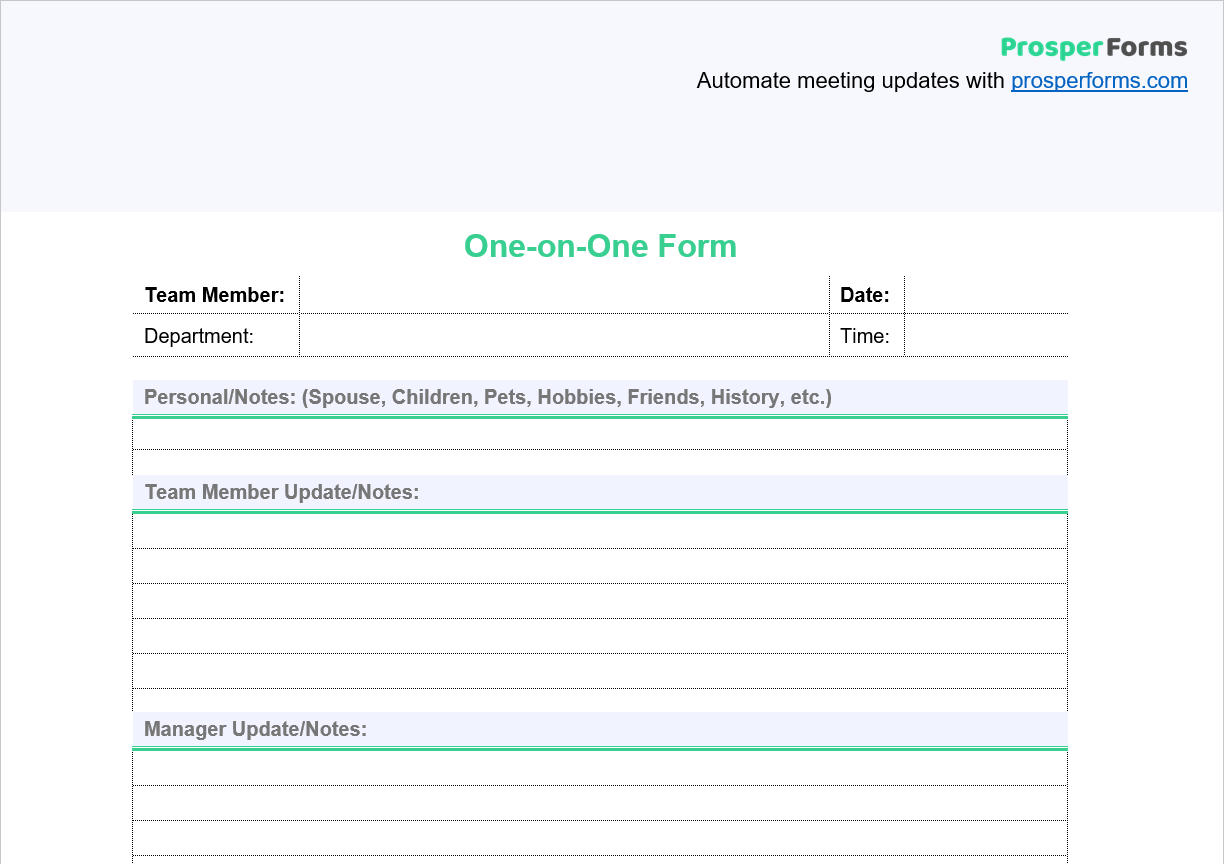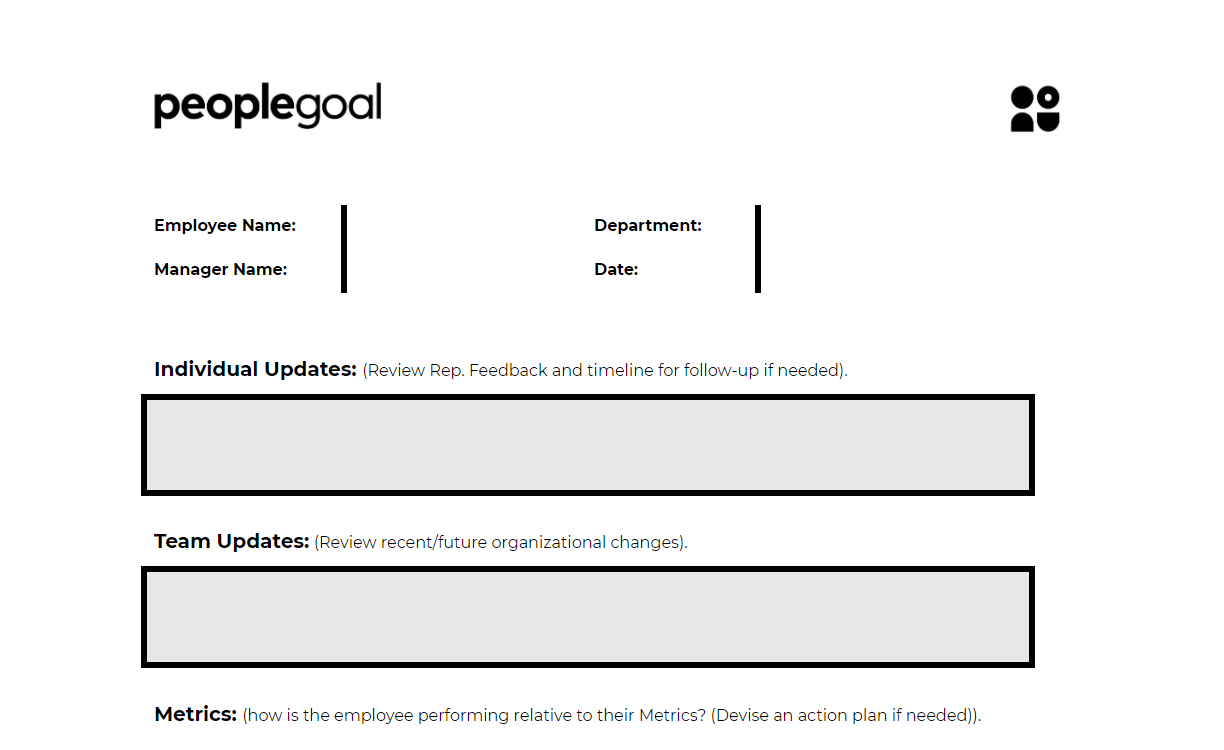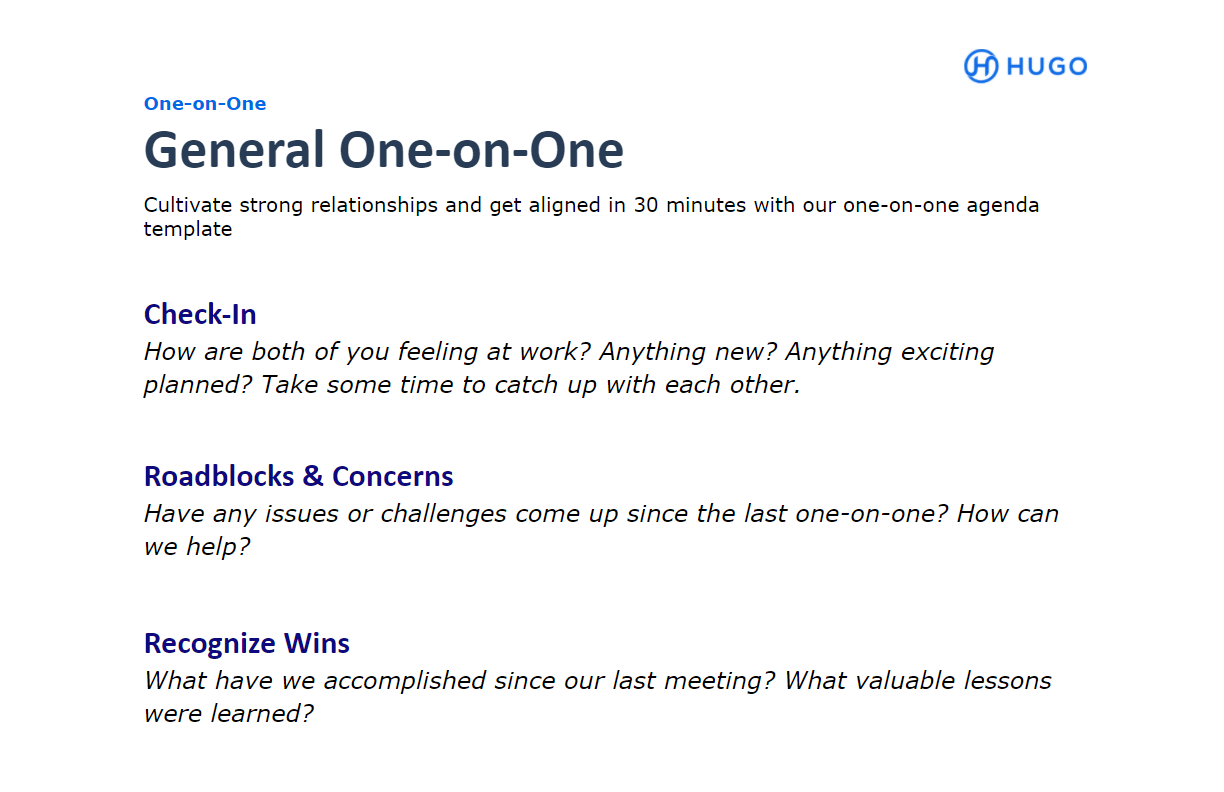One-on-one meetings are powerful, personalized tools organizations can use to engage their employees. It provides a way to give feedback and garner insight into performance, development, motivation, and growth.
If you’re a manager, director, or executive, you can seriously benefit from learning the ins and outs of one-on-one meetings.
Not sure where to start? Don’t worry. This article will cover everything you need to know, including:
- What a one-on-one meeting is
- Why one-on-one meetings are so powerful
- Tips to run a one-on-one meeting
- How your one-on-one meeting agenda should look
- One-one-one meeting templates
Ready? Let’s dive on in.
What Is an One-on-One Meeting?
One-on-one meetings are a type of meeting that a manager holds with an individual employee. They generally cover career issues regarding, performance, development, motivation, and growth. One-on-one meetings are also referred to as 1:1s, check-ins, and 121s.
They’re typically held once a week, and run for roughly 30 minutes at a time. The purpose of 1:1 meetings is to assess the level of engagement of an individual employee. Are they happy? How exactly are they feeling about their current role?
One-on-one meetings are also used to give updates on current projects and tasks. Are they on schedule? Are there any problems or roadblocks that need to be addressed? At an organizational level, they act as tools to engage and retain a team of employees.
Why Are 1 on 1 Meetings so Powerful?
One-on-one meetings are so powerful because they’re personal, treating every team member as an individual. Each person gets their own time to discuss various issues of their role with their direct report/manager/subordinate.
From an organizational standpoint, 1:1 meetings:
- Strengthen relationships: brings a personal element to all relations within a team and organization.
- Identify problems and roadblocks: brings awareness and solutions to issues before they become too large.
- Detail performance: provides a way to ensure every employee is on track towards completing their workflows, tasks, and projects.
- Show recognition: acknowledges the hard work and effort that individual employees contribute to an organization.
How to Prepare an One-on-One Meeting?
Both managers and employees need to adequately prepare for a one-on-one meeting. Both parties must bring information to the discussion, to ensure all areas are covered.
Choose an Appropriate Schedule
A one-on-one meeting will need to be held at an appropriate time for both the manager and the employee. 1:1s are a type of formal meeting that is held frequently — usually once a week. Sometimes it might be once a fortnight.
Choose an Appropriate Time
How long the 1:1 meeting will go for is also important. Most last around 30 minutes, which gives enough time to cover items on the agenda.
Agree on an Agenda
When it comes to planning a one-on-one meeting, there’s nothing more important than having an agenda. This is basically a schedule of events for your meetings — what you’ll be talking about. Both the manager and the employee will contribute to this.
Agendas will be discussed in detail later on in this article.
Review and Prepare Using the Agenda
Both a one-on-one meeting takes place, you’ll want to go over the agenda in your head. Think of it much like a script for a play, or acting role. You need to truly understand the items, topics, and issues that’ll be discussed. Ensure you are confident you can answer all of them.
Acquire the Right Mindset
One-on-one meetings are not like other meetings. They’re intensely personal, and require more active involvement. After all, there’s only two people involved.
With that said, try to mentally prepare yourself to speak and contribute, as much listen and hear. Both parties will be actively contributing to a 1:1 meeting.
Be Proactive
One-on-one meetings require contribution and effort from both participants — manager and employee. Sometimes however, one party isn’t bringing the involvement and commitment they should be.
This isn’t a time to get angry or shift blame. Instead, be proactive and try to get them in sync, in the loop, afloat. 1:1 meetings are an ongoing activity, so it’s definitely something you can work on and better prepare for.
Don’t Forget to Follow Up
Because one-on-ones are an ongoing activity, it’s important to follow up in between and before future meetings. Every new 1:1 will discuss a different agenda, comprising old and new items. Ensure that you continually add new topics to the agenda as they arise.
Later on in this post we’ll cover having a “shared space,” which allows you to actively add new agenda issues.
Tips to Run an One-on-One Meeting
Having trouble running your one-on-one meetings? Don’t worry — try implementing these best practice actionable tips featured below.
Have an Agenda
Having an agenda is the absolute easiest way to ensure your 1:1s are a success. It’s basically a plan — an outline for what you’ll discuss during the meetings. It may seem like common sense, but you’d be surprised at how many organizations wing it regarding one-on-one meetings.
Simply put? This is not a place to cut corners and get lazy. Having no plan is planning to fail.
The ins and outs of agendas will be discussed later on in this article.
Take Notes
During the one-on-one meeting, you’ll want to make sure that notes are being taken. Ideally both the employee and the manager should be writing or typing things down. Remember — this is a meeting where both parties are listening and contributing.
Taking notes will allow you to better absorb and retain the information given in the meeting. This could be handwritten in person, or typed into a Word/Google doc if online.
Keep it Time-based
Along with having an agenda you should also ensure that it’s being followed in a timely manner. As in, you should allocate a specific amount of time to every item that needs to be discussed.
Typically a 1:1 meeting will go for 30 minutes. Give a fair amount of time for both parties to have their say.
Ask the Right Questions
If your meetings still aren’t feeling right, then it may just be what you’re talking about. You simply might not be asking the right questions.
Your agenda should cover all the important details. Don’t just add topics, create specific questions. You’re looking for specific answers, so the questions you ask really do matter.
Use This Simple Structure
If you’re still stuck trying to figure out best how to run your 1:1 meeting, perhaps try using this structure:
- Their update
- Your update
- Outlook
This is a simple way to look at the format of a one-on-one meeting. One party updates first, the second follows suit, then an outlook to future meetings. If you’ve got 30 minutes then you can spend 10 minutes each, and 5 looking towards the future.
How Should Your One-on-One Meeting Agenda Look Like?
Going into your one-on-one meeting, you need to make sure you have an agenda — a good one at that.
Your meeting agenda are the details and activities you cover during your one-on-one meeting. Basically the content and criteria of your meeting.
Why Do You Need an Agenda For Your One-on-One Meetings?
An agenda brings structure to your one-on-ones, which helps increase the effectiveness of the meetings. It’s like having a plan, an outline that’s known beforehand. The agenda will help reduce awkwardness and stagnancy — you’ll both already know what to speak about.
What Sort of Topics/Questions Should Your Agenda Include?
Not sure about what your one-on-one meeting agendas should include? Remember — 1:1s are used to assess performance, development, motivation, and growth. Any and all topics/questions regarding those issues are applicable.
Here are some rough ideas of agenda topics you might talk about:
- Project updates
- Roadblocks, problems, and bottlenecks
- Budget issues
- Performance review, feedback, and reflection
- Goals
- Wins and successes
Find and identify the topics, questions, and issues most important, that must be discussed. This goes for both the manager and the employee.
Create the Agenda Together
Oftentimes one-on-one meetings fail to be effective because the agenda was created by only one party. The content, topics, and questions of the meetings were created by only the manager, or employee.
Ideally, your one-on-one meeting agenda should be contributed to by both parties. You should have a shared file/location where both can actively create, track, and add new items to the agenda.
Without having a shared space for agenda items like this, your meeting will be ineffective, falling off track. You’ve only got an allotted amount of time, typically 30 minutes. Both the manager and the employee need to know all the questions of each other's minds.
Keep Your Agenda Shared Space Clean and Structured
You’ve got a space/location for both the manager and employee to contribute agenda items. Great. Now you should look to cleanly organize and structure it.
One-on-one meetings are an ongoing activity, and you’ll constantly be adding and prioritizing different agenda items. The idea here is to create a bunch of subcategories that’ll make creating your ideal weekly agendas easy.
Here are some examples of subcategories you should create for your shared space:
- Urgent: agenda items that need to be discussed and dealt with ASAP.
- Not urgent: topics, issues, and items that aren’t urgent and can be pushed back to later one-on-one meetings.
- Problems: any roadblocks that require discussion during a 1:1 meeting.
- Successes: all wins that have been achieved — it’s important to discuss these.
- Goals: milestones, whether personal, performance, or project related.
Bringing this sort of organization and structure to your agenda shared space will help you prioritize the most important issues. Every week you’ll be addressing the most pertinent and urgent of agenda topics, which is how it should be.
Continually Update and Add New Agenda Items
The key to making your shared space work is to continually add and categorize new agenda items as they arise. As you go about your daily workflows, tasks and projects, always consider adding new things to the shared space.
Got a question about your department’s budget? Add it and categorize it to the shared space.
Uncovered a bottleneck, roadblock, or problem with your current project? Add it and categorize it to the shared space.
Feeling a lack of motivation and unfulfillment in your current role? Add it and categorize it to the shared space.
These are all potential agenda items that you should be discussing during one-on-one meetings. Ensuring you add these items immediately, as they arise, will ensure your meetings run smoothly.
You don’t want to be scrambling at the last minute to put all the pieces together. Add items to the shared space ontime, giving both manager and employee necessary prep time. This’ll get the most of each and every one-on-one meeting.
One-on-One Meeting Templates You Can Use
Below, you’ll find 3 awesome templates that’ll help you run your 1:1 meetings.
1. One-on-One Form - ProsperForms

ProsperForms has an epic free 1:1 meeting template you can use. It’ll help you plan, outline, and execute your meeting. The template covers:
- Personal notes: any personal details that might be addressed/covered.
- Team member notes: insight and update from the employee.
- Manager notes: feedback and information from the manager.
- Future notes: outlook towards future meetings, goals, and plans.
This is an easy, simplified template for one-on-one meetings that’ll provide structure and consistency. Using it will help you keep inline with your agenda for sure.
2. One-on-One Meeting Template - Peoplegoal

Peoplegoal offers an awesome one-on-one meeting template for free. It’ll help you put together the most effective one-on-one meeting possible. The template includes:
- Individual Updates: review of feedback, and timeline for follow-up.
- Team Updates: recent and future projects and organizational updates.
- Metrics: how is performance relative to metrics?
- Personal Goals: what are their personal goals? How close are they to achieving them?
- Comments/Feedback: any necessary final comments.
It’s a great template because it covers pretty much everything you need for 1:1s. It adapts to whatever you need it to be.
3. General One-on-One Template - Hugo

Hugo is another option for a free one-on-one meeting template. This is a simple template, designed for 30 minute 1:1s, which is the standard length they usually go for. The template covers:
- Check-In: any new personal updates?
- Roadblocks + Concerns: any issues relating to projects, workflows, and tasks.
- Recognize Wins: successes in the recent time period.
- Updates on Objectives: how are current projects, workflows, and tasks going?
- Action Items: what specific actions must be taken to reach set goals?
- Revisit Later: any items on the agenda that should be discussed in the next 1:1?
- Feedback: any and all potential feedback.
- Follow-Up: when will the next one-on-one meeting be?
Hugo’s free template is fantastic because it’s extremely extensive compared to others out there. It covers just about anything and everything you can think of regarding 1:1 meetings.
Conclusion
This article covered everything you need to know about one-on-one meetings.
One-on-one meetings are an effective way to individually engage, motivate, and retain your employees. By treating each worker as a unique person, you empower them. Make sure you implement the information in this article today, so you’re 1:1’s can go to the next level.
Got a question? Ask away. We love to hear from our readers.
